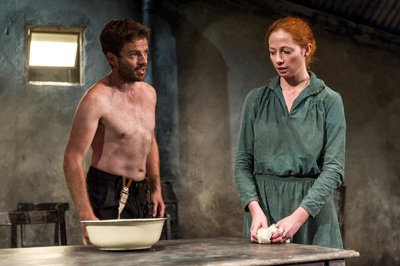Playboy of the Western World.
A review by George Fleeton.
 SIXTEEN months ago the reimagined Lyric Theatre Belfast launched a new phase of its illustrious life, which had begun in 1968, with a superb production of Arthur Miller’s play The Crucible, his 60 year old chef-d’œuvre, reviewed here on DownNews on 07-05-2011.
SIXTEEN months ago the reimagined Lyric Theatre Belfast launched a new phase of its illustrious life, which had begun in 1968, with a superb production of Arthur Miller’s play The Crucible, his 60 year old chef-d’œuvre, reviewed here on DownNews on 07-05-2011.
That production had been directed by Conall Morrison, who returned this month to open the Lyric’s autumn/winter seasonfor 2012 with a robust and resounding staging of J M Synge’s The Playboy of the Western World, first seen, heard and unappreciated, in the Abbey Theatre Dublin in 1907.
Today this play often has to face fiercely into a wind of shallow criticism which labels it as stage-Irish, paddy-whackery, full of splenetic lallygaggers and scofflaws, celebrating wanton drunkenness and brawling.
Whereas the Lyric production under review does foreground those elements of the text, it is worth pausing to consider some of the deeper concerns of Synge’s mind at the time lest we forget that this capital Irish drama is as important to our understanding of Celtic oral culture as anything written about their mythical past for Greek audiences 2,250 years ago by Aeschylus, Sophocles or Euripides.
For Christy Mahon, and Pegeen Mike, reach out to us on the modern stage as credible shades of Prometheus, Œdipus, and Medea, each giving expression to what had never previously been expressed, in languages that had never before been heard or spoken in the public arena of the theatre.
All theatre comprises writing, performing and witnessing.
Witnessing is crucial to its efficacy, because theatre, like murder or marriage, only works if you see it: it only happens if you are there.
To witness a production today, of this century-old play, is to see and hear the compassion with which Synge looked upon his peasant inspirations, frequent contact with whom had moulded his imagination.
It is the truthfulness of his observations then that impresses us now.
Synge had learnt much from Jack Yeats.

Both of them had personally witnessed the depths of poverty in the western world of Mayo – Yeats drew and painted it, Synge described it in his essays and plays.
We know that Synge was perturbed on his many visits to the Aran and Blasket islands and had found that those communities had so much to give and were yet so unfulfilled.
There is an explanation for this that might help our understanding of Synge’s wider vision for his play.
The native spirit of late 19th century west of Ireland, with its attendant civilisation, had been broken by hunger and emigration, and the country had grown old without maturing.
There was a loneliness created by these economic and social setbacks and the ineffable sadness of this – as reflected in story, song, poetry and music – was a denying force, working against personal and communal self-fulfilment.
Synge witnessed all of this, and determined to do his limited best to set down the character of the people about him so that some record of their compromised scramble, on the most hostile edge of Europe, might live after them, ‘for the like of us will never be again’, as Tomás Ó Criomhthain wrote on the last page of The Islandman in 1929.
The dramaturgy of The Playboy of the Western World deals equally well with that most fascinating enigma in all performance art (as identified by Aristotle – more thinker than playwright – for whom form and content were the inseparable constituents of all drama): namely the chasm which exists between appearance and reality, today referred to as the romance of illusion, that is, do we live by the dream or by the fact? – as in Pegeen Mike’s line, addressing Christy,
… the blow of a loy (has) taught me that there’s a great gap between a gallous story and a dirty deed.
It was here that the Lyric production scored well. And the search for identity, as a basic plot concept, was also well treated, especially Christy’s curious, comic but credible odyssey from ploughboy to potboy to playboy.
He searches for and finds more than Pegeen Mike; he finds himself and she is ultimately no more than the catalyst in the painful process of his discovery of self, as he transcends his frightened, inarticulate former persona and blossoms into a real man.
She forsakes him, because he tried to repeat the very patricide which had attracted her to him in the first place and she, forsaking him, loses him.
From among a cast that consistently caught so much of the poetry, music and irony of a western world receding into romantic history, Orla Fitzgerald and Patrick Moy stood out, their experience lending backbone to the whole piece and their performances were nicely balanced by the ensemble playing of Bríd Ní Neachtain and Lalor Roddy (the Widow Quinn and Old Mahon), with all the other parts constituting a fine Greek chorus.
The use of the pause was split-second sharp, although the night-to-dawn transition, Act 1 to Act 2, was very flat.
But the energies consumed throughout, particularly in the physicality of the final father/son struggles, were impressive.
‘Praise youth and it will prosper’ goes the Irish proverb, which just about sums up a piece of theatre that risks becoming an ageing, anachronistic melodrama.
This is not art house theatre, after all, yet who among the critics in 1907 would have thought it possible to stand Sophocles’ Œdipus on its head and to write successfully about a lad cast out, not for having killed his father, but for having bungled the job?
As the newspaper editor remarks, in John Ford’s last significant western The Man who shot Liberty Valance (1962): ‘This is the West, sir. When the legend becomes fact, print the legend.’
George Fleeton writes independently on arts and culture and teaches opera and cinema in higher education.

























